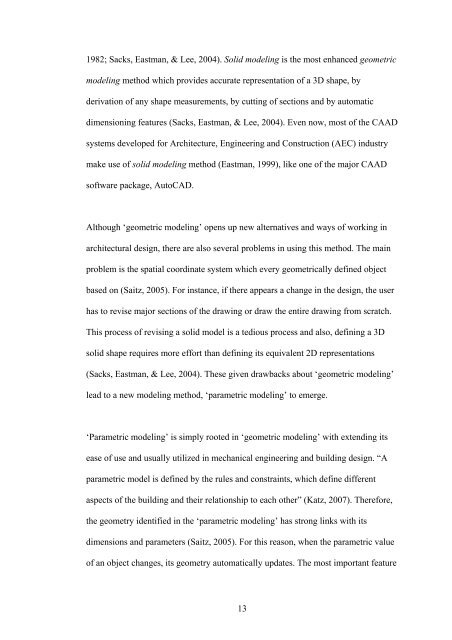critical analysis of the absence of interior - Bilkent University
critical analysis of the absence of interior - Bilkent University
critical analysis of the absence of interior - Bilkent University
You also want an ePaper? Increase the reach of your titles
YUMPU automatically turns print PDFs into web optimized ePapers that Google loves.
1982; Sacks, Eastman, & Lee, 2004). Solid modeling is <strong>the</strong> most enhanced geometric<br />
modeling method which provides accurate representation <strong>of</strong> a 3D shape, by<br />
derivation <strong>of</strong> any shape measurements, by cutting <strong>of</strong> sections and by automatic<br />
dimensioning features (Sacks, Eastman, & Lee, 2004). Even now, most <strong>of</strong> <strong>the</strong> CAAD<br />
systems developed for Architecture, Engineering and Construction (AEC) industry<br />
make use <strong>of</strong> solid modeling method (Eastman, 1999), like one <strong>of</strong> <strong>the</strong> major CAAD<br />
s<strong>of</strong>tware package, AutoCAD.<br />
Although ‘geometric modeling’ opens up new alternatives and ways <strong>of</strong> working in<br />
architectural design, <strong>the</strong>re are also several problems in using this method. The main<br />
problem is <strong>the</strong> spatial coordinate system which every geometrically defined object<br />
based on (Saitz, 2005). For instance, if <strong>the</strong>re appears a change in <strong>the</strong> design, <strong>the</strong> user<br />
has to revise major sections <strong>of</strong> <strong>the</strong> drawing or draw <strong>the</strong> entire drawing from scratch.<br />
This process <strong>of</strong> revising a solid model is a tedious process and also, defining a 3D<br />
solid shape requires more effort than defining its equivalent 2D representations<br />
(Sacks, Eastman, & Lee, 2004). These given drawbacks about ‘geometric modeling’<br />
lead to a new modeling method, ‘parametric modeling’ to emerge.<br />
‘Parametric modeling’ is simply rooted in ‘geometric modeling’ with extending its<br />
ease <strong>of</strong> use and usually utilized in mechanical engineering and building design. “A<br />
parametric model is defined by <strong>the</strong> rules and constraints, which define different<br />
aspects <strong>of</strong> <strong>the</strong> building and <strong>the</strong>ir relationship to each o<strong>the</strong>r” (Katz, 2007). Therefore,<br />
<strong>the</strong> geometry identified in <strong>the</strong> ‘parametric modeling’ has strong links with its<br />
dimensions and parameters (Saitz, 2005). For this reason, when <strong>the</strong> parametric value<br />
<strong>of</strong> an object changes, its geometry automatically updates. The most important feature<br />
13
















